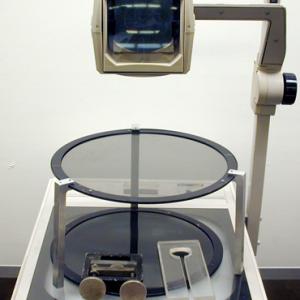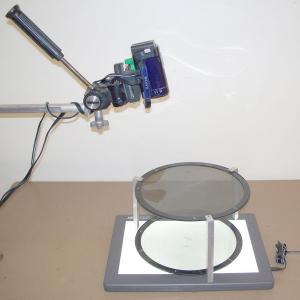College of Liberal Arts & Sciences
6H35.50 - Polarization - Stress on Plastic and Glass
See also 1R20.70 in Mechanics.
The overhead plates and equipment are used to show stress is plastics and transmission properties of different thickness plastics, etc.
Prince Rupert's drops are an example of stressed glass. Place these between two crossed Polaroids and observe the stress in the glass directly.
NOTE: You will not be able to project the stress in the drops with the overhead projector due to the round nature of the drops.
However, using a slide viewer and a video camera or the document camera will enable you to project this to the class.
- Carl E. Mungan, "Polarization by Reflection", TPT, Vol. 61, #3, March 2023, p. 164.
- Jennifer J. Birriel, "Birefringence Without Polarizers", TPT, Vol. 61, #1, Jan. 2023, p. 86.
- Chokchai Puttharugsa, Patamas Bintachitt, Surawut Wicharn, Suwan Plaipichit, "Demonstrating Birefringence Using a Smartphone Camera", TPT, Vol. 60, #3, March 2022, p. 232.
- Steve Dail, "Polarized Patterns", TPT, Vol. 51, #4, Apr. 2013, p. 245.
- Marchall Ellenstein, "The Broken-Protractor Prediction Trick", TPT, Vol. 40, #1, Jan 2002, p. 52.
- Alfred F. Leung and Henning Sagehorn, "Polarization by Reflection in a Plastic Box", TPT, Vol. 35, #8, Nov. 1997, p. 461.
- Paul Chagnon, "Animated Displays IV: Linear Polarization", TPT, Vol. 31, #8, Nov. 1993, p. 489, and referenced in Resource Letter TLC-1 Teaching Light and Color, Demonstration Experiments Resource Articles.
- G. R. Davies, "Polarized Light Corridor Demonstration", TPT, Vol. 28, #7, Oct. 1990, p. 464.
- Joe L. Ferguson, "Two Semiquantitative Demonstrations of Stress Birefringence", AJP, Vol. 64, #10, Oct. 1996, p. 1338.
- G. R. Davies, "Display of Interference in Highly Convergent Linearly Polarized White Light", AJP, Vol. 50, #11, Nov. 1982, p. 1051.
- George Barnes, "Photoelasticity Demonstration With an Overhead Projector", AJP, Vol. 44, #11, Nov. 1976, p. 1138.
- "O-660: Strain Polyethylene-Beam Model", DICK and RAE Physics Demo Notebook.
- George M. Hopkins, "Polarized Light", Experimental Science, p. 240.
- John Henry Pepper, "On Light", Cyclopadic Science Simplified, p. 120.
- Jearl Walker, "6.129, Colors and Spots and Polarization", The Flying Circus of Physics Ed. 2, p. 296.
- "Polarization", The Illustrated Science and Invention Encyclopedia.
- Hollis N. Todd, Polarization of Light, p. 1 - 47.
- "13, Mechanical Stresses in Polarized Light (Photoelasticity)", Experiments in Optics, Part 2, Klinger Scientific Apparatus Corp., Bulletin 101- 2.
- "12, Internal Stresses by Reflective Polarization", Experiments in Optics, Part 2, Klinger Scientific Apparatus Corp., Bulletin 101- 2.
- T. D. Rossing and C. J. Chiaverina, "7.7, Photoelasticity", Light Science, Physics and Visual Arts, p. 163.
- T. D. Rossing and C. J. Chiaverina, "Appendix J, Activity 5, Birefringence", Light Science, Physics and Visual Arts, p. 403.
- Brian Jones and Matt Fackelman, "Polarized Light Demo", Don't Forget the Duct Tape, p. 93 - 96.
Disclaimer: These demonstrations are provided only for illustrative use by persons affiliated with The University of Iowa and only under the direction of a trained instructor or physicist. The University of Iowa is not responsible for demonstrations performed by those using their own equipment or who choose to use this reference material for their own purpose. The demonstrations included here are within the public domain and can be found in materials contained in libraries, bookstores, and through electronic sources. Performing all or any portion of any of these demonstrations, with or without revisions not depicted here entails inherent risks. These risks include, without limitation, bodily injury (and possibly death), including risks to health that may be temporary or permanent and that may exacerbate a pre-existing medical condition; and property loss or damage. Anyone performing any part of these demonstrations, even with revisions, knowingly and voluntarily assumes all risks associated with them.


